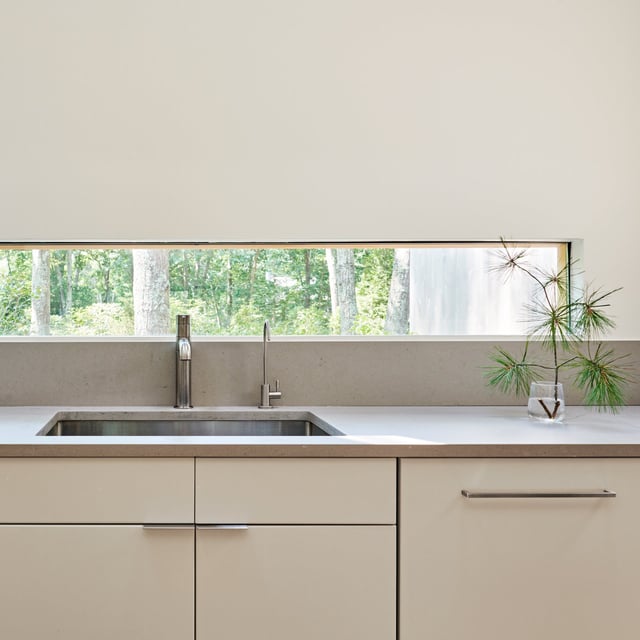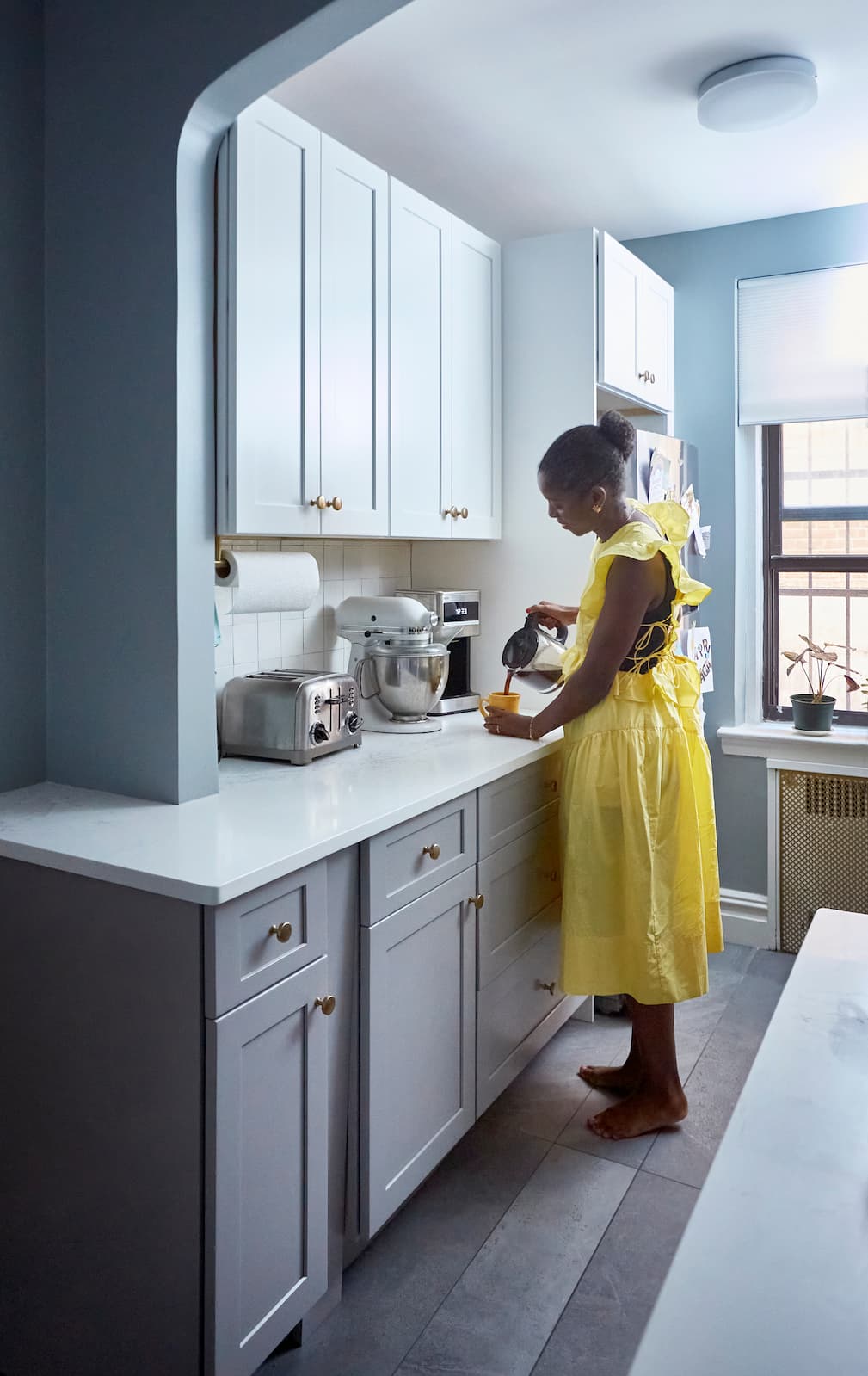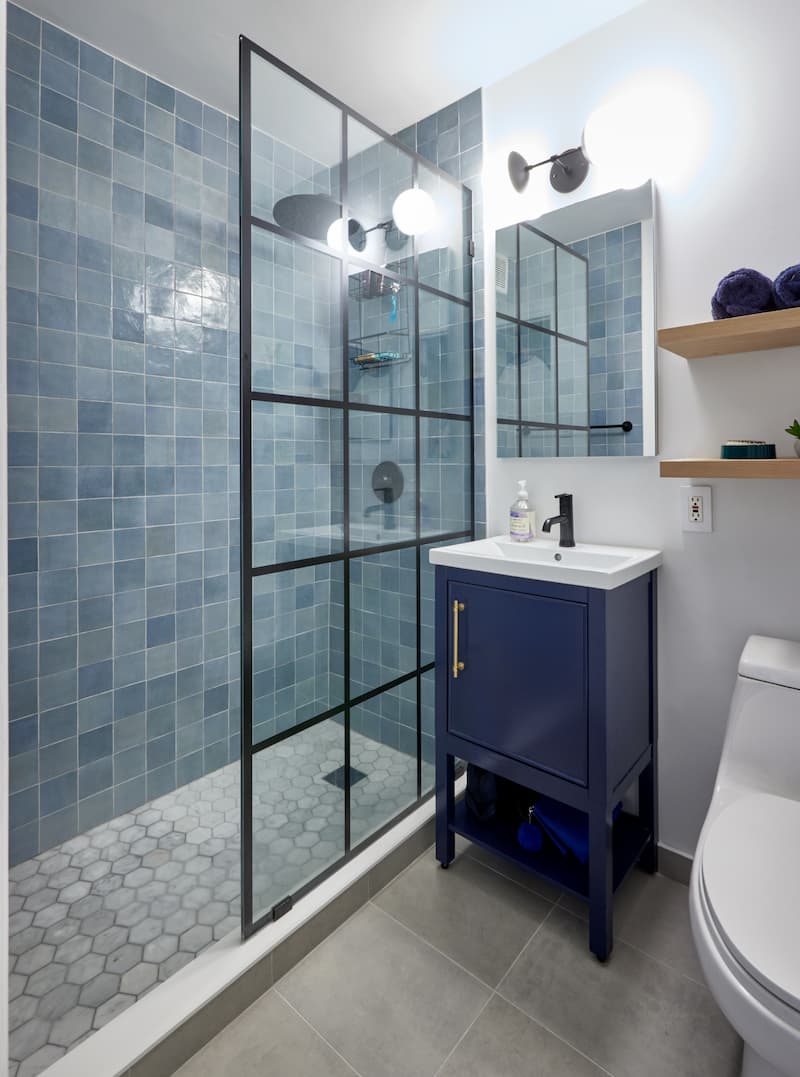Eco-friendly Home Renovation Ideas to Transform How You Live

In This Article
Renovating with the environment in mind is about making choices that tread lighter on the planet—without giving up comfort or style. It could mean choosing sustainable materials, boosting your home’s energy efficiency, or designing spaces that are healthier for you and the people you live with. Whether you’re tackling a full remodel or just making a few smart upgrades, each decision adds up. Over time, you’ll have a home that not only works for your life, but also reflects your values and contributes to a more sustainable future.
Eco-Friendly Interior Building Materials
Communicating your sustainability goals to your interior designer and contractor helps them recommend eco-friendly materials for specific use cases, from your choice of insulation to countertops and light fixtures. However, when beginning your own brainstorm, look to:
- Bamboo: Bamboo is a fast-growing, renewable resource ideal for flooring, cabinetry, and wall treatments. Its natural strength and resilience make it a practical choice for busy households. Bamboo’s unique grain adds warmth and character to your renovation, and it’s available in a variety of finishes to suit your style.
- Reclaimed Wood: Reclaimed wood gives new life to materials salvaged from old buildings, barns, or factories. It’s perfect for flooring, beams, shelving, and accent walls, adding a sense of history and character to your home’s remodel. Choosing reclaimed wood reduces demand for new lumber and helps preserve forests.
- Recycled Glass: Recycled glass is often used for countertops, tiles, and backsplashes. It’s made from post-consumer glass, keeping waste out of landfills and offering a distinctive, colorful look. However, its benefits extend beyond its eco-friendly nature; recycled glass surfaces are durable, easy to clean, and can be a conversation starter in your kitchen or bath.
- Cork: Cork is harvested from the bark of cork oak trees without harming the tree, making it a renewable, eco-friendly material to use throughout your renovation. It’s naturally resistant to mold, mildew, and pests, making it a smart choice for flooring and wall coverings. Cork also provides a soft, comfortable surface underfoot and excellent sound insulation.
- Low-VOC Paints: Low-VOC (volatile organic compound) paints release fewer harmful chemicals into your home’s air. They’re available in a wide range of colors and finishes, making it easy to find the right look for any room. Using low-VOC paints supports better indoor air quality and a healthier living environment.
- Recycled Metal: Recycled steel, aluminum, and copper can be used for countertops, backsplashes, and fixtures. These materials are durable, stylish, and help reduce the need for new mining. Recycled metal often features unique patinas and finishes, adding visual interest to your renovated space.
- Wool Insulation: Wool insulation is a natural, renewable alternative to traditional fiberglass. It’s effective at regulating temperature and moisture, and it’s safe to handle and install. A smart and versatile addition to your eco-friendly renovation, wool is also naturally fire-resistant and can help improve indoor air quality.
- Linoleum: Made from natural materials like linseed oil, wood flour, and cork dust, linoleum is a classic eco-friendly flooring option that’s both biodegradable and durable. It’s available in a wide range of colors and patterns, making it easy to match your design vision. As a bonus, linoleum is also naturally antimicrobial and easy to maintain.
- Recycled Plastic Composite: Recycled plastic composite materials are used for decking, fencing, and even cabinetry. They’re made from post-consumer plastics, reducing landfill waste and offering a long-lasting, low-maintenance alternative to wood. These composites resist moisture, insects, and fading, making them ideal for both indoor and outdoor use.
- Hempcrete: Hempcrete is a bio-composite material made from the inner fibers of the hemp plant mixed with lime. It’s used for insulation and non-structural walls, offering excellent thermal performance and breathability. Hempcrete is lightweight, mold-resistant, and has a much lower carbon footprint than traditional concrete.
Repair and Refresh Instead of Replacing
Eco-friendly home renovations are also about making the most of what you already have. Before you decide to replace a fixture or finish, consider whether it can be repaired, restored, or updated. This approach reduces waste, conserves resources, and often preserves the unique character of your home.
For example, instead of removing and discarding an old bathtub, reglazing the surface can give it a fresh, like-new appearance at a fraction of the environmental and financial cost. The same principle applies to kitchen cabinets—refinishing or repainting existing cabinetry can completely transform your space while keeping usable materials out of the landfill. Similarly, choosing to refinish hardwood floors instead of replacing them preserves valuable wood and significantly cuts down on construction waste.
Choosing to repair and refresh not only supports a more sustainable renovation, but it can also reveal the charm and craftsmanship of your home’s original features. When you work with your contractor or designer, let them know you’re interested in restoration options—they may have creative solutions that align with your eco-friendly goals.
Not sure how to begin your renovation?
Get free, expert guidance from a dedicated Block Project Planner who can help you navigate proposals, timelines, contractor selection, and more.
Book A Free Consultation
Assess Your Own Home’s Energy Efficiency
Before making changes, it’s helpful to understand how your home currently uses energy. A home energy assessment can reveal where improvements will have the biggest impact—saving you money and reducing your environmental footprint.
Telltale Signs of an Inefficient House and How to Audit
Some signs that your home may be wasting energy include rooms that are difficult to heat or cool, frequent drafts, high utility bills, or condensation on windows. You might also notice uneven temperatures between rooms or excessive dust, which can indicate air leaks. To audit your home’s efficiency, start by trying to find drafts around windows and doors, inspecting insulation in attics and basements, and reviewing your energy bills for unusual spikes.
Many homeowners benefit from a professional energy audit, where a specialist uses tools like blower doors and infrared cameras to pinpoint problem areas and recommend targeted improvements.
Common Culprits for Energy Inefficiency
- Drafty Windows and Doors: Gaps and poor seals let conditioned air escape, making your heating and cooling systems work harder. Over time, this can lead to higher energy bills and less comfort. Replacing weatherstripping or upgrading to energy-efficient windows and doors can make a noticeable difference.
- Outdated Appliances: Older appliances often use more energy than newer, efficient models. They may lack modern features that help conserve electricity and water. Upgrading to ENERGY STAR® certified appliances can lower your utility costs and reduce your home’s carbon footprint.
- Insufficient Insulation: Poor insulation in walls, attics, or basements can lead to significant heat loss in winter and heat gain in summer. This forces your HVAC system to run longer and more frequently. Adding or upgrading insulation helps maintain a consistent indoor temperature and improves comfort.
- Inefficient Lighting: Incandescent bulbs use more energy and have a shorter lifespan than LED alternatives. Lighting can account for a significant portion of your electricity use, especially in larger homes. Switching to LEDs is a simple upgrade that pays off quickly.
- Aging HVAC Systems: Older heating and cooling systems may be less efficient and more prone to breakdowns. They often lack the advanced controls and sensors found in modern units. Regular maintenance or upgrading to a high-efficiency system can improve performance and lower energy use.
- Leaky Ductwork: Ducts that are poorly sealed or insulated can lose a significant amount of heated or cooled air before it reaches your living spaces. This not only wastes energy but can also make some rooms less comfortable. Sealing and insulating ductwork helps ensure your HVAC system operates efficiently.
- Single-Pane Windows: Single-pane windows offer little insulation compared to double- or triple-pane options. They can contribute to drafts, condensation, and temperature fluctuations. Upgrading to multi-pane windows can improve comfort and reduce energy loss.
- Old Water Heaters: Traditional water heaters can be a major source of energy waste, especially if they’re more than 10 years old. They may take longer to heat water and lose heat through the tank walls. Consider replacing it with a high-efficiency or tankless model for better performance.
Additional Tips for Improving Energy Efficiency
Upgrade to Energy-Efficient Appliances
Replacing outdated appliances with ENERGY STAR® certified models can significantly reduce your home’s energy and water use. These appliances are designed to meet strict efficiency standards without sacrificing performance. Over time, the savings on your utility bills can offset the initial investment, making this a smart long-term choice.
Install a Programmable Thermostat
A programmable thermostat allows you to automate your home’s heating and cooling schedule. By setting temperatures to adjust when you’re asleep or away, you can avoid wasting energy on climate control when it’s not needed. Many models also offer remote access and learning features for even greater convenience and savings.
Consider Solar Panels
If your home receives ample sunlight, solar panels can help you generate your own clean electricity. While the upfront cost can be significant, many homeowners see a return on investment through lower energy bills and available tax incentives. Solar panels can also increase your home’s value and reduce your reliance on the grid.
For more renovation strategies focused on reducing energy usage, read 15 Energy Efficient Home Improvements That Save You Money.
Design a Home That’s Uniquely Yours
Block can help you achieve your renovation goals and bring your dream remodel to life with price assurance and expert support.
Get Started
Bonus Renovation Ideas for an Eco-Friendly Home
Install Low-Flow Plumbing Fixtures
Low-flow faucets, showerheads, and toilets use less water without sacrificing performance. These fixtures can help you conserve water and lower your utility bills. Many are easy to install and available in styles that match your bathroom or kitchen design.
Choose Sustainable Landscaping
Opt for native plants and drought-resistant species that require less water and maintenance. Sustainable landscaping can reduce your outdoor water use and support local ecosystems. Incorporating permeable paving and rain gardens can also help manage stormwater runoff.
Add a Rainwater Collection System
Collecting rainwater for garden irrigation is an effective way to reduce your reliance on municipal water. Simple barrel systems can be installed under downspouts, or you can invest in more advanced setups for larger gardens. Using rainwater helps conserve resources and can keep your landscaping healthy during dry spells.
Use Smart Home Technology
Smart lighting, and energy monitors help you track and manage your home’s energy use in real time. These tools can identify patterns and suggest ways to save, making it easier to stay on top of your efficiency goals. Many smart devices can be controlled remotely, adding convenience and peace of mind. To learn more, read Smart Home Renovation Ideas to Include in Your Next Remodel.
Opt for Durable, Long-Lasting Materials
Choosing materials that stand up to daily wear means fewer replacements and less waste over time. Look for products with strong warranties and proven track records for durability. Investing in quality now can save resources and money in the long run.
Where to Learn About Eco-Friendly Tax Credits
Making your home more sustainable doesn’t just benefit the environment—it can also offer financial advantages. Many eco-friendly home renovations and energy-efficient upgrades qualify for tax credits, rebates, or other incentives at the federal, state, and local levels. These programs can help offset the upfront cost of improvements like solar panels, high-efficiency appliances, insulation, and more.To find the most up-to-date information and see which incentives you may qualify for, start with these trusted resources:
- ENERGY STAR® Rebate Finder: The ENERGY STAR Rebate Finder lets you search for rebates and special offers on certified products by zip code.
- Database of State Incentives for Renewables & Efficiency (DSIRE): DSIRE is a comprehensive database of federal, state, and local incentives for renewable energy and energy efficiency. You can search by state and project type to see what’s available in your area.
- IRS Energy Credits: The IRS website provides details on current federal tax credits for energy-efficient home improvements, including eligibility requirements and how to claim them.
- Local Utility Providers: Many utility companies offer their own rebates or incentives for energy-saving upgrades. Check your provider’s website or contact their customer service team to learn more.
- State and Local Government Websites: Your state or city’s official website often lists additional programs or grants for eco-friendly home remodeling.
Taking the time to research these resources can help you make the most of your eco-friendly renovation. If you’re working with a contractor or project planner, ask if they’re familiar with available incentives—they may be able to guide you through the application process or recommend upgrades that qualify.
Renovate with confidence every step of the way
Step 1: Personalize Your Renovation Plan
Step 2: Receive Quotes from Trusted Contractors
Step 3: Let Us Handle the Project Details

Design a Home That Aligns with Your Values, with Help from Block Renovation
Every renovation is an opportunity to create a home that feels right for you—and for the planet. When you work with Block Renovation, you’ll have access to expert guidance, vetted contractors, and tools that make it easier to prioritize sustainability at every step. From selecting eco-friendly materials to improving your home’s energy performance, we’re here to help you build a space that reflects your values and supports a healthier future.

Written by Block Renovation

Renovate confidently with Block
Easily compare quotes from top quality contractors, and get peace of mind with warranty & price protections.
Thousands of homeowners have renovated with Block

4.5 Stars (100+)

4.7 Stars (100+)

4.5 Stars (75+)
Renovate confidently
- Top quality contractors
- Warranty & price protections
- Expert resources

